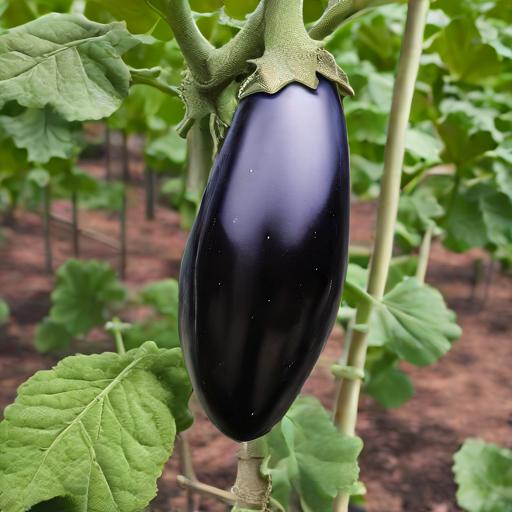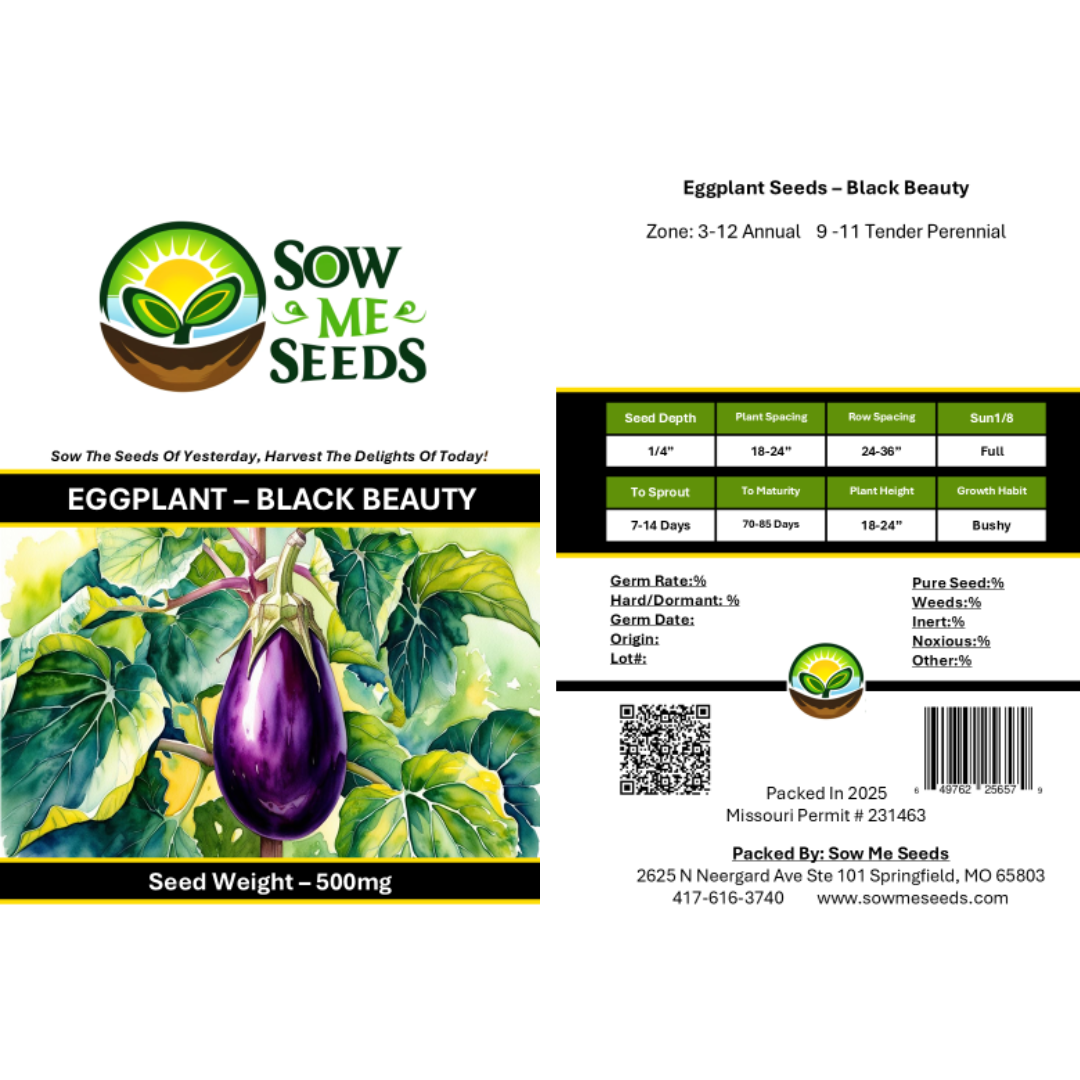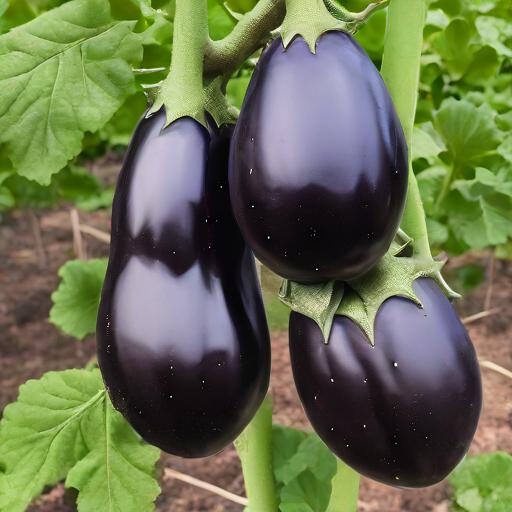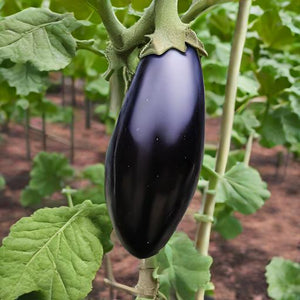- Hardiness Zone: 3-12 Annual
- Can Be Grown As A Perennial In Tropic Zones
Seed Depth: 1/4 inch
Seed Spacing: 18–24 inches
Row Spacing: 24–36 inches
Sunlight: Full sun
Days to Sprout: 7–14 days
Days to Maturity: 70–85 days
Growth Habit: Upright, Bushy
Sunlight: Choose a location that receives full sun for at least 6-8 hours a day. Eggplants thrive in warm, sunny conditions.
Soil: Prefers well-drained, fertile soil with a pH between 6.0 and 6.8. Amend the soil with compost or well-rotted manure to enhance fertility and drainage.
When to Plant: Eggplants are warm-season crops that should be planted after the danger of frost has passed and the soil has warmed to at least 60°F (16°C). In cooler climates, start seeds indoors 8-10 weeks before the last expected frost date.
Starting Indoors: Sow seeds 1/4 inch deep in seed-starting mix. Keep the soil moist and maintain a temperature of 75-85°F (24-29°C). Transplant seedlings outdoors when they are 6-8 inches tall and all danger of frost has passed.
Direct Sowing: In warm climates, seeds can be sown directly in the garden once the soil has warmed. Sow seeds 1/4 inch deep and 2-3 feet apart in rows spaced 3-4 feet apart.
Succession Planting: Not typically needed; plants produce continuously throughout the growing season.
Watering: Keep the soil consistently moist but not waterlogged. Water eggplants regularly, especially during dry periods. Mulch around the plants to retain soil moisture and suppress weeds.
Fertilization: Eggplants are heavy feeders. Apply a balanced fertilizer or compost at planting time and again when the plants start to flower. Side-dress with compost or a balanced fertilizer every 4-6 weeks during the growing season.
Mulching and Weeding: Apply a layer of mulch around the plants to retain soil moisture, suppress weeds, and keep the soil temperature consistent. Hand-pull weeds carefully to avoid disturbing the shallow roots of the eggplants.
Staking: Black Beauty Eggplants can become heavy with fruit and may need staking to support the weight. Use garden stakes or tomato cages to keep the plants upright.
Pruning: Remove yellowing or damaged leaves to improve airflow and focus energy on fruit production. Stake or cage plants to support heavy fruit.
Pest and Disease Management: Eggplants can be susceptible to pests such as flea beetles, aphids, and spider mites. Use organic pest control methods like neem oil, insecticidal soap, or hand-picking to manage infestations. Practice crop rotation and ensure good air circulation to prevent fungal diseases like powdery mildew and verticillium wilt.
When to Harvest: Black Beauty Eggplants are typically ready to harvest 70-80 days after transplanting. Harvest when the fruits are glossy, firm, and about 6-8 inches long.
How to Harvest: Use a sharp knife or pruning shears to cut the fruit from the plant, leaving a short stem attached. Handle the fruits gently to avoid bruising.
Storing Fresh Eggplant: Freshly harvested eggplants can be stored in a cool, dry place for up to a week. For longer storage, place them in a plastic bag in the refrigerator. Avoid storing eggplants in very cold temperatures, as this can cause chilling injury.
Why You’ll Love It
Heirloom Favorite: A staple in home gardens for decades due to its flavor and reliability.
Large Fruits: Produces broad, teardrop-shaped eggplants that average 1–3 pounds each.
Heat-Loving: Thrives in warm weather and keeps producing with regular harvesting.
Versatile in the Kitchen: Perfect for everything from eggplant parmesan to summer grilling.
Plant Characteristics
Height: 24–36 inches
Growth Habit: Upright and bushy with broad leaves and sturdy stems
Fruit Type: Glossy, deep purple-black oval fruits with green calyx
Days to Maturity: 75–85 days
Hardiness: Warm-season annual
Flavor and Culinary Uses
Flavor: Mild, earthy, and slightly sweet with a meaty texture
Culinary Uses: Ideal for grilling, roasting, baking, stuffing, and Mediterranean dishes like baba ganoush
Companion Planting Tips
Good Companions: Beans, peppers, marigolds, and thyme
Avoid Planting Near: Fennel or other nightshades (for rotation purposes)
Bonus Benefit: Attracts pollinators and can double as an ornamental in the garden
Common Issues and Solutions
Flea Beetles: Use floating row covers early and mulch to reduce pest access
Blossom Drop: Ensure consistent watering and avoid excess nitrogen
Bitter Taste: Harvest while fruits are still glossy and firm for the best flavor
Seeds Per Packet
| 500mg | Approximately 105 |
| 2g | Approximately 420 |
Why You’ll Love It
Heirloom Favorite: A staple in home gardens for decades due to its flavor and reliability.
Large Fruits: Produces broad, teardrop-shaped eggplants that average 1–3 pounds each.
Heat-Loving: Thrives in warm weather and keeps producing with regular harvesting.
Versatile in the Kitchen: Perfect for everything from eggplant parmesan to summer grilling.
Plant Characteristics
Height: 24–36 inches
Growth Habit: Upright and bushy with broad leaves and sturdy stems
Fruit Type: Glossy, deep purple-black oval fruits with green calyx
Days to Maturity: 75–85 days
Hardiness: Warm-season annual
Flavor and Culinary Uses
Flavor: Mild, earthy, and slightly sweet with a meaty texture
Culinary Uses: Ideal for grilling, roasting, baking, stuffing, and Mediterranean dishes like baba ganoush
Companion Planting Tips
Good Companions: Beans, peppers, marigolds, and thyme
Avoid Planting Near: Fennel or other nightshades (for rotation purposes)
Bonus Benefit: Attracts pollinators and can double as an ornamental in the garden
Common Issues and Solutions
Flea Beetles: Use floating row covers early and mulch to reduce pest access
Blossom Drop: Ensure consistent watering and avoid excess nitrogen
Bitter Taste: Harvest while fruits are still glossy and firm for the best flavor
Seeds Per Packet
| 500mg | Approximately 105 |
| 2g | Approximately 420 |





Share and get 15% off!
Simply share this product on one of the following social networks and you will unlock 15% off!